Anticoagulation for Mechanical valves
Anticoagulation for Surgical Procedures in patients with Mechanical valves For high risk non-cardiac surgeries in...
Choice of valve prosthesis for mitral valve replacement
Contents1 Mechanical prosthesis is recommended for patients for mitral valve replacement2 Guideline from ACC/AHA in...
Clinical Questions -1
Contents1 What is the indication of Transvaginal ultrasound in this case of Hydatidiform mole ?2...
Image Question-24
Contents1 What is the diagnosis of Image?2 Bunch of Grapes sign3 Bunch of Grapes sign...
Endocrinology in Relation to Reproduction
Contents1 Corpus luteum of pregnancy secretes all except2 Which cell organelle is abundantly present in...
Metabolic Adaptations in Pregnancy
Contents1 All are true of carbohydrate metabolism in pregnancy except2 Not true of physiological changes...
The fetal membranes
Contents1 What describes chorion best2 Not a function of Amniotic fluid3 Not a feature of...
Mitral Valve – Surgical Considerations
Contents1 Stiffness of the valve decreases in the presence of –2 ALL are TRUE about...
The Placenta
Contents1 Thickness of placenta increases up to2 Not true of placenta3 Not a part of...
Ovarian Failure
Contents1 The most common genetic form of premature ovarian insufficiency ( POI) is2 Anti-ovarian antibodies...
Heart Failure -I
What is the commonest cause of heart failure?
Ischaemic heart disease - 35–40%
Cardiomyopathy (dilated) - 30–34% Hypertension - 15–20%
Weight loss of 4.5 kg in ............ days in response to treatment is a Framingham major criteria.
The Framingham criteria for the diagnosis of heart failure consists of the concurrent presence of either two major criteria or one major and two minor criteria.
Major criteria comprise the following:
Paroxysmal nocturnal dyspnea
Weight loss of 4.5 kg in 5 days in response to treatment
Neck vein distention
Rales
Acute pulmonary edema
Hepatojugular reflux
S 3 gallop
Central venous pressure greater than 16 cm water
Circulation time of 25 seconds or longer
Radiographic cardiomegaly
Pulmonary edema, visceral congestion, or cardiomegaly at autopsy
Minor criteria (accepted only if they cannot be attributed to another medical condition) are as follows:
Nocturnal cough
Dyspnea on ordinary exertion
A decrease in vital capacity by one third the maximal value recorded
Pleural effusion
Tachycardia (rate of 120 bpm)
Hepatomegaly
Bilateral ankle edema
Licorice can worsen heart failure by -
Licorice can worsen heart failure by increasing blood pressure and promoting fluid retention.
Yohimbine can exacerbate heart failure by increasing blood pressure through -
Yohimbine can exacerbate heart failure by increasing blood pressure through alpha-2 adrenergic receptor antagonism
Which of the following stages of heart failure the patient belongs to when the patient has structural heart disorder, but no symptoms at any stage?
Stage A: People at high risk for developing HF in the future, but no functional or structural heart disorder Stage B: A structural heart disorder, but no symptoms at any stage Stage C: Previous or current symptoms of heart failure in the context of an underlying structural heart problem, but managed with medical treatment Stage D: Advanced disease requiring hospital-based support, a heart transplant, or palliative care
Heart failure cells are -
Heart failure cells are siderophages generated in the alveoli of the lungs of people with left heart failure or chronic pulmonary edema
Patients who achieve at least............. MET-minutes/week had lower heart failure
Recommended minimum by U.S. guidelines -
Patients who achieve at least 500 MET-minutes/week had lower heart failure
Which of the following should be used in those patients who still have symptoms while on an ACE-I or ARB, beta blocker, and a mineralocorticoid receptor antagonist?
Sacubitril/valsartan should be used in those who still have symptoms while on an ACE-I or ARB, beta blocker, and a mineralocorticoid receptor antagonist as it reduces the risks of cardiovascular mortality and hospitalization for heart failure by a further 4.7% (absolute risk reduction).
All of the following is used for risk Stratification in heart failure EXCEPT?
Framingham criteria for the diagnosis of heart failure
Tolvaptan antagonises which of the following receptor?
VAPTANS
Unselective (mixed V1A/V2)
Conivaptan
V1A selective (V1RA)
Relcovaptan
V1B selective (V3RA)
Nelivaptan
V2 selective (V2RA)
Lixivaptan
Mozavaptan
Satavaptan
Tolvaptan
Atrial fibrillation occurs in approximately ------------% of patients with heart failure.
Atrial fibrillation occurs in approximately 20% of patients with heart failure and causes further impairment of cardiac function
Medicine Review MCQs-XVI
Which of the following is Naturally occurring cysteine-rich antibacterial and antifungal polypeptides?
Defensins are naturally occurring cysteine-rich antibacterial and antifungal polypeptides
- 29–35 amino acids
Mast cells share features in common with which of the following cell?
Mast cells share features in common with - Basophils
- Histamine-containing granules
- High-affinity receptors for immunoglobulin E
All of the following are TRUE about Histamine EXCEPT -
Histamine - constitutes 10% of the mast cell’s weight
IgM is a useful diagnostic test for -
- IgM is a useful diagnostic test for recent infection.
- IgG dominates in the second exposure to antigen
CD4+ T cells also known as -
T helper cells-
- assist other lymphocytes, including maturation of B cells into plasma cells and memory B cells,
- activation of cytotoxic T cells and macrophages.
- These cells are also known as CD4+ T cells as they express the CD4 glycoprotein on their surfaces.
IgA2 concentration are higher in -
IgA exists in two isotypes, IgA1 and IgA2.
They are both heavily glycosylated proteins.
While IgA1 predominates in serum (~80%),
IgA2 percentages are higher in secretions than in serum (~35% in secretions)
Which of the following vasculitis caused by deposits of IgA?
Henoch–Schönlein purpura - Known as IgA vasculitis - is a disease of the skin, mucous membranes
All of the following are vasculitis where mostly small vessels are affected EXCEPT -
According to the size of the vessel affected, vasculitis can be classified into:
- Large vessel: Takayasu's arteritis, Temporal arteritis
- Medium vessel: Buerger's disease, Kawasaki disease, Polyarteritis nodosa
- Small vessel: Behçet's syndrome, Eosinophilic granulomatosis with polyangiitis, Cutaneous vasculitis, granulomatosis with polyangiitis, Henoch–Schönlein purpura, and microscopic polyangiitis.
Which is the most commonly implicated drug in causing Linear IgA bullous dermatosis?
Most commonly implicated drug - Vancomycin
All of the following are TRUE Light-chain multiple myeloma EXCEPT -
Light-chain multiple myeloma is a less frequent type of multiple myeloma with a more aggressive course and poorer prognosis.
It is characterized by the inability of the malignant plasma cells to produce heavy chains, resulting in the exclusive production of light chains. Therefore, no M-spike is visible in serum protein electrophoresis.
Exclusive production of light chains No M-spike is visible in serum protein electrophoresis.
Hematology MCQs-I
Criteria for AMML is confirmed if the myleoblasts and promonocytes in the bone marrow are greater than ?
Criteria for AMML is confirmed if the myleoblasts and promonocytes in the bone marrow are greater than 20 percent.
All of the following are TRUE about AML EXCEPT -
AML is slightly more common in men, with a male-to-female ratio of 1.3:1
Acute promyelocytic leukemia has the highest curability
Auer rods are seen in -
Auer rods [also called Auer bodies] - are large, crystalline cytoplasmic inclusion bodies observed in myeloid blast cells -
- acute myeloid leukemia,
- acute promyelocytic leukemia,
- high-grade myelodysplastic syndromes
- myeloproliferative disorders.
Which cytogenetic abnormalities in pediatric and adult B-ALL shows favorable prognosis?
Hyperdiploidy (>50 chromosomes) in B-ALL Shows Favorable prognosis
Which is the commonest malignancy in pediatrics age group?
Most common types of cancer are leukemias, followed by brain and other CNS tumors, lymphomas, neuroblastoma, kidney tumors
Leukemias, which are cancers of the bone marrow and blood, are the most common childhood cancers. They account for about 28% of all cancers in children. The most common types in children are acute lymphocytic leukemia (ALL) and acute myeloid leukemia (AML)
Which is TRUE for Philadelphia chromosome EXCEPT ?
All cases of CML are positive for BCR-ABL1
Fusion gene BCR-ABL1 - coding for a hybrid protein: a tyrosine kinase signalling protein that is "always on", causing the cell to divide uncontrollably by interrupting the stability of the genome and impairing various signaling pathways governing the cell cycle.
Blast crisis in CML is diagnosed if -
Blast crisis in CML is diagnosed if -
>20% blasts in the blood or bone marrow
The presence of an extramedullary proliferation of blasts
What is the test of choice in adults to distinguish CML from Leukemoid reaction?
Philadelphia chromosome is translocation between chromosomes -
Philadelphia chromosome -Ph1 (a reciprocal translocation of chromosomal material between chromosomes 9 and 22)
BCR/ABL mutation
Hepatitis C virus (HCV) is considered as a riskfactor of -
Both the hepatitis B virus (HBV) and hepatitis C virus (HCV) have been implicated in the pathogenesis of chronic lymphocytic leukemia
Image Question-12

Analyzing profile ...
What is the Probable diagnosis of the slide?
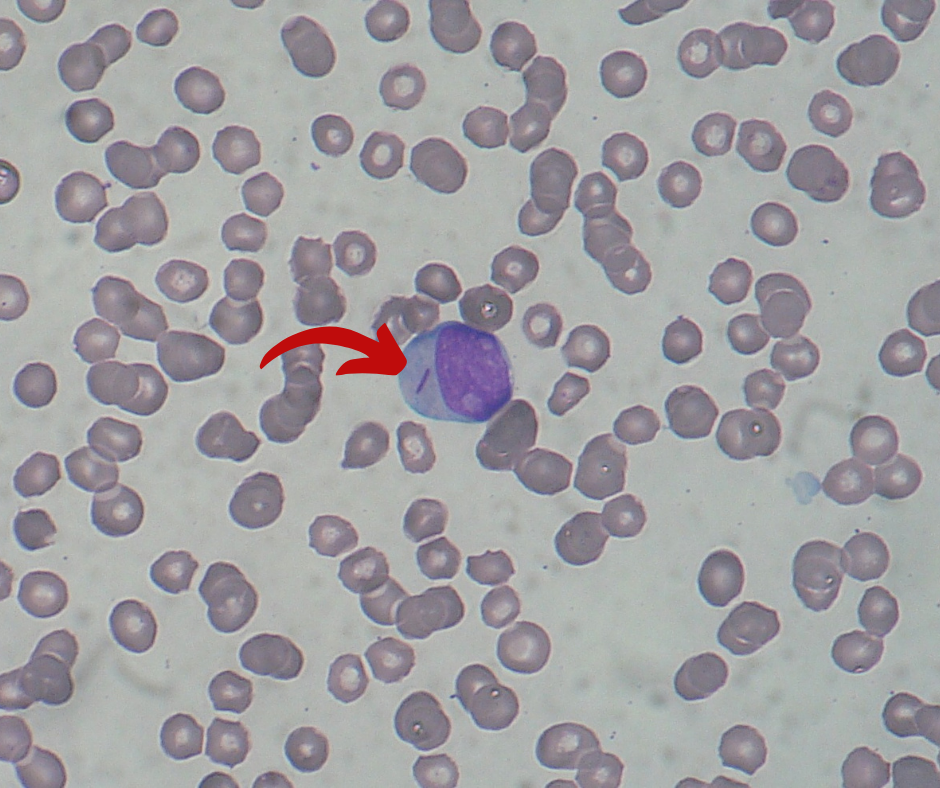

Please login with Facebook to see your result
Image Question-14




Analyzing profile ...
What is the Probable diagnosis of the slide?
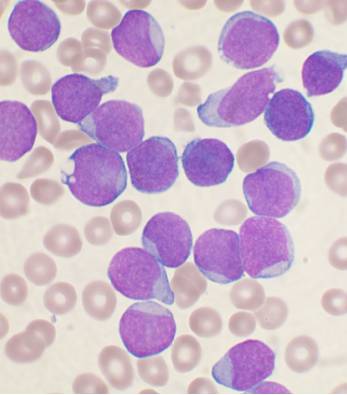

Please login with Facebook to see your result
Share your Results:
Medicine Review MCQs-XV
Which is the richest food source of Vitamin A?
Vitamin A
The richest food source is liver,
Also found in milk, butter, cheese, egg yolks and fish oils.
Beta-carotene is the main carotenoid found in green vegetables, carrots and other yellow and red fruits.
Other carotenoids, lycopene and lutein,
All of the following are unoxygenated (oxygen free) carotenoids EXCEPT ?
Carotenoids with molecules containing oxygen, such as lutein and zeaxanthin, are known as xanthophylls
The unoxygenated (oxygen free) carotenoids such as α-carotene, β-carotene, and lycopene, are known as carotenes. Carotenes typically contain only carbon and hydrogen (i.e., are hydrocarbons),
Which is the most common form of vitamin -B12 used in dietary supplements
Cyanocobalamin is the most common form used in dietary supplements and food fortification because cyanide stabilizes the molecule against degradation.
Which of the following is given in cyanide poisoning?
Hydroxocobalamin
Injected intravenously for the purpose of treating cyanide poisoning, as the hydroxyl group is displaced by cyanide, creating a non-toxic cyanocobalamin that is excreted in urine.
Pernicious anemia characterised by the presence of antibodies to ?
Pernicious anemia-
characterised by stomach atrophy and the presence of antibodies to parietal cells and intrinsic factor
Which is TRUE regarding autoantibodies in Pernicious anemia?
Around 85% of PA patients have parietal cell antibodies, which means they are a sensitive marker for the disease.
Intrinsic factor antibodies are much less sensitive than parietal cell antibodies, but they are much more specific.
Increase in blood levels of Methylmalonic acid and Homocysteine suggests?
Methylmalonic acid and homocysteine - metabolic products that can be measured in the blood.
Increase in the levels of both helps differentiate between vitamin B12 deficiency and folic acid deficiency.
homocysteine alone increases in the Folic acid deficiency.
Which of the following is false for Pernicious anemia?
H. pylori and Zollinger-Ellison syndrome may also cause a form of nonautoimmune gastritis that can lead to pernicious anemia
Diphyllobothrium latum causes --------------- deficiency in humans
Diphyllobothrium latum causes B12 deficiency in humans. >br> Diphyllobothrium latum absorbs around 80% of dietary B12
Administration of which anesthesia can precipitate subacute combined degeneration in people with subclinical vitamin B12 deficiency?
Through oxidation, nitrous oxide inactivates vitamin B12.
In its inactive form, vitamin B12 is unable to function as a co-factor for methionine synthase and methylmalonyl coA mutase.
Methionine synthase converts homocysteine into methionine, which is necessary for the production of myelin proteins, while also converting 5-methyl-tetrahydrofolate into tetrahydrofolate, which is necessary for DNA synthesis.
Image Question-15




Analyzing profile ...
What is the Likely Diagnosis?
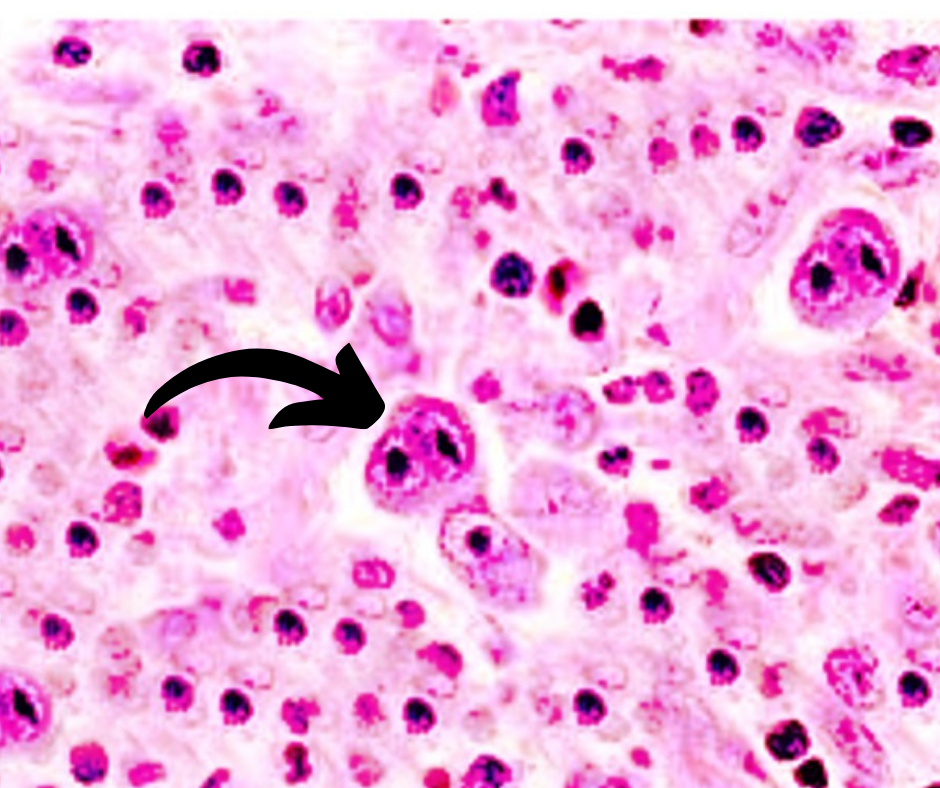

Please login with Facebook to see your result
Medicine Review MCQs-XIV
Microscopy of a patient blood smear shows Slightly larger RBCs with Grey blue colour on Gimsa stain preparation. what are those cells?
Poikilocytosis is the term for abnormally shaped red blood cells in the blood. Poikilocytes may be flat, elongated, teardrop-shaped, crescent-shaped, sickle-shaped, or may have pointy projections, or other abnormal features.
Polychromasia is a disorder where there is an abnormally high number of immature red blood cells found in the bloodstream as a result of being prematurely released from the bone marrow during blood formation.These cells are often shades of grayish-blue.
Codocytes are most commonly seen in -
Target cells are also called codocytes.
Codocytes-Most commonly seen in thalassemia, which are due to impaired production of hemoglobin (Hb).
Image shows Supravital stain of a smear of human blood from a patient with hemolytic anemia. What is the cell marked by arrow?
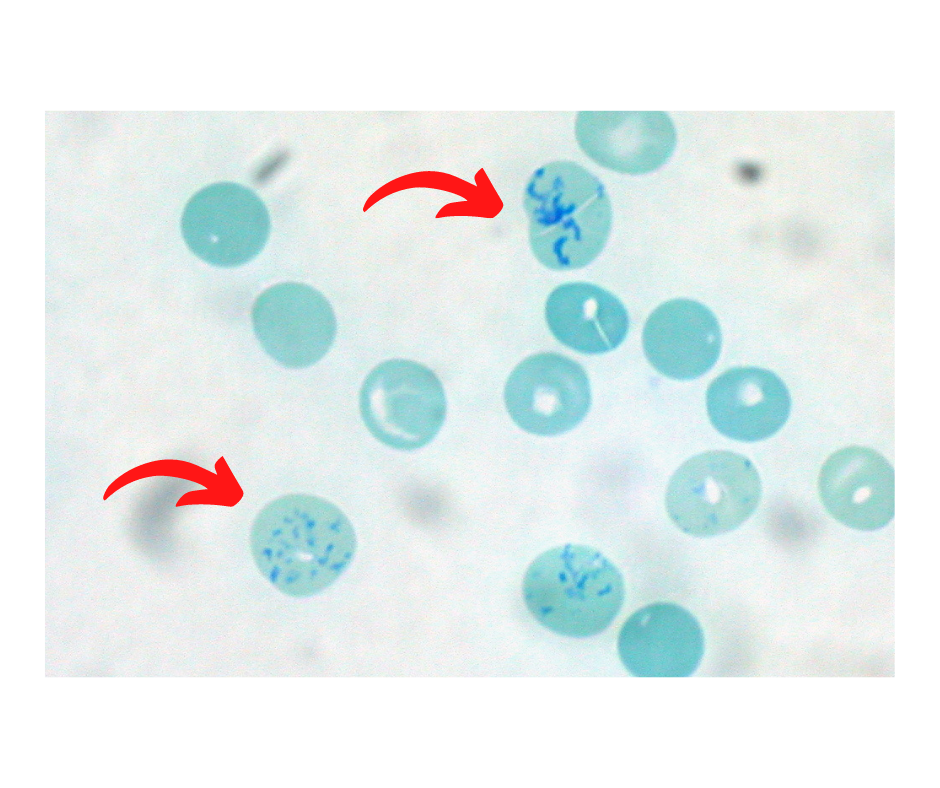

Supravital stain of a smear of human blood :
From a patient with hemolytic anemia.
The reticulocytes are the cells with the dark blue dots and curved linear structures (reticulum) in the cytoplasm.
Hereditary spherocytosis is most commonly due to mutations in genes that code for -
spectrin (alpha and beta), ankyrin, band 3 protein, protein 4.2
Hereditary Spherocytosis autosomal recessive inheritance usually account for -
Recessive inheritance may account for 20-25% of all HS cases
Which is the condition where cell marked in the IMAGE is seen most commonly ?
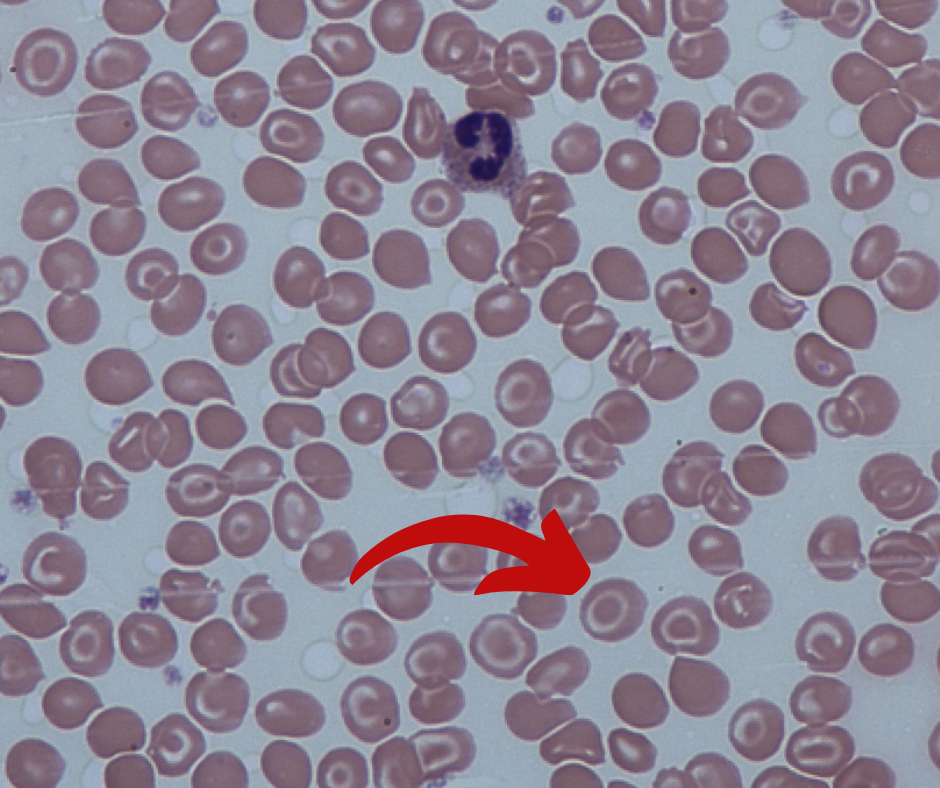

Target cells (codocytes): Most commonly seen in thalassemia.
Normal Hb has two alpha, and two beta chains, a decrease in alpha chains is alpha thalassemia, a decrease in beta chains is beta-thalassemia.
Target cells appear in association with the following conditions: Liver disease: Lecithin—cholesterol acyltransferase (LCAT) activity may be decreased in obstructive liver disease. Alpha-thalassemia and beta-thalassemia Hemoglobin C Disease Iron deficiency anemia Post-splenectomy Autosplenectomy
Amino acid substitution of lysine for glutamic acid at position six of the beta hemoglobin chain results in which of the following?
Hemoglobin S- coding of valine instead of glutamate in position 6 of the hemoglobin beta chain
Howell–Jolly body are seen in most commonly which of the following condition ?
Howell–Jolly body is a cytopathological finding of basophilic nuclear remnants (clusters of DNA) in circulating erythrocytes
Spleens are also removed for therapeutic purposes in conditions like hereditary spherocytosis, trauma to the spleen, and autosplenectomy caused by sickle cell anemia.
Myelodysplastic syndrome can transform into which of the following?
Myelodysplastic syndrome (MDS) often transforms into acute myeloid leukemia [AML].
Transformation of MDS into acute lymphoblastic leukemia (ALL) is extremely rare.
In Myelodysplastic syndrome if Bone-marrow myeloblasts rises over ---------% it is considered transformation to acute myelogenous leukemia [WHO] ?
Overall percentage of bone-marrow myeloblasts rises over a particular cutoff (20% for WHO and 30% for FAB), then transformation to acute myelogenous leukemia (AML) is said to have occurred.
Reticulocyte index for a healthy individual should be in range?
Reticulocyte index (RI) should be between 0.5% and 2.5% for a healthy individual.
Medicine Review MCQs-XIII
All of the following are CORRECT for Bernard–Soulier syndrome EXCEPT -
Bernard–Soulier syndrome
Low platelet count
Bernard–Soulier syndrome -caused by a deficiency of the glycoprotein Ib-IX-V complex (GPIb-IX-V), the receptor for von Willebrand factor
What is the Marked structure in Image?
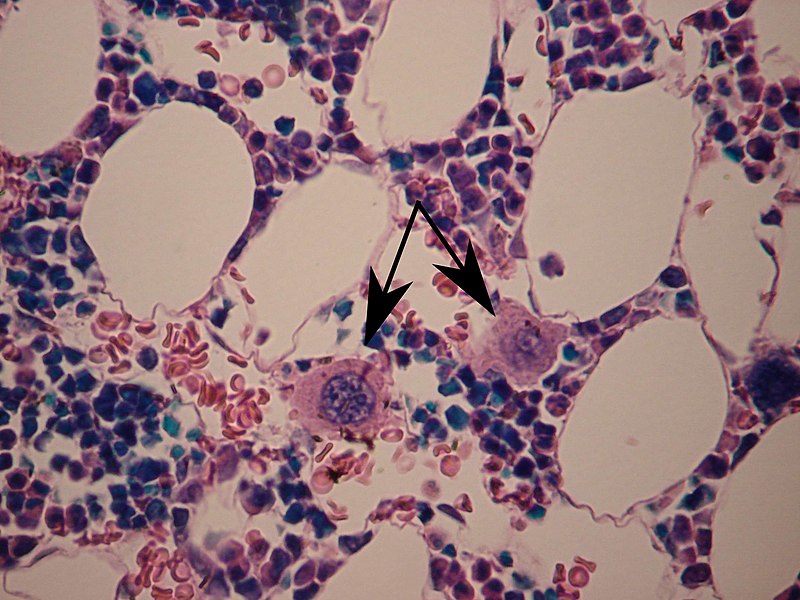

Megakaryocytes in bone marrow -marked with arrows
Platelet-producing megakaryocytes go through ................during cell differentiation
Platelet-producing megakaryocytes go through endomitosis during cell differentiation
Megakaryocytes are derived from ................... stem cell
Megakaryocytes are derived from hematopoietic stem cell precursor cells in the bone marrow. They are produced primarily by the liver, kidney, spleen, and bone marrow.
The primary signal for megakaryocyte production is -
The primary signal for megakaryocyte production is thrombopoietin
sufficient but not absolutely necessary for inducing differentiation of progenitor cells in the bone marrow towards a final megakaryocyte phenotype.
All of the following include Lymphoid cells EXCEPT -
Lymphoid cells include T cells, B cells, natural killer cells, and innate lymphoid cells.
Clock Face Nucleus seen in -
Plasma cell nucleus - cartwheel or clock face arrangement
Reed-Sternberg cells seen in -
Hodgkin lymphoma characteristically presents with Hodgkin and Reed-Sternberg cells.
When the cells are mononucleated, they are called Hodgkin cells.
When they are multinucleated, they are called Reed-Sternberg cells.
Owl’s Eye Appearance nucleus seen in -
Owl's eye appearance of the Lentiform nucleus of the basal ganglia seen on head CT scan images of patients with -
Cerebral hypoxia
Medicine Review MCQs -XII
Asbestosis can cause all of the following EXCEPT -
Asbestosis can cause - Lung cancer, Mesothelioma, and Pulmonary heart disease.
More than ------- % of people affected with asbestosis develop plaques in the parietal pleura
>50%
The commonest manifestation of asbestos exposure is pleural disease, including pleural plaques and diffuse pleural thickening (DPT). Malignant mesothelioma of the pleura and DPT are less common than plaques,
Which of the following patients are particularly susceptible to tuberculosis
Patients with silicosis are particularly susceptible to tuberculosis
Chalicosis is a form of pneumoconiosis caused by the inhalation of fine particles of stone -
Chalicosis is a form of pneumoconiosis affecting the lungs or bronchioles, found chiefly among
Ferruginous body is a histopathologic finding in interstitial lung disease suggestive of ?
Ferruginous body is a histopathologic finding in interstitial lung disease suggestive of - Asbestosis
Ferruginous body - appear as small brown nodules in the septum of the alveolus. Ferruginous bodies are typically indicative of asbestos inhalation (when the presence of asbestos is verified they are called "asbestos bodies")
Caplan's syndrome is a combination of rheumatoid arthritis (RA) with -
Caplan's syndrome is a combination of rheumatoid arthritis (RA) with Pneumoconiosis
Anthracosis a form of
Coal workers' pneumoconiosis, severe state, develops after the initial, milder form of the disease known as anthracosis
Anthracosis - Asymptomatic and is found to at least some extent in all urban dwellers due to air pollution.
Asbestosis causes all EXCEPT -
As the fibrosis progresses, a number of more definite findings are seen, which continue to be particularly subpleural and lower lung zone in distribution. They include:
-parenchymal bands
-traction bronchiectasis
-honeycomb fibrosis
In which of the following pleural plaques are pathognomonic on X-ray?
Pleural plaques are pathognomonic on X-ray - Asbestosis
All of the following are found in Silicosis EXCEPT -
Ferruginous body - Small brown nodules in the septum of the alveolus
What is the MOST LIKELY diagnosis of X-RAY?
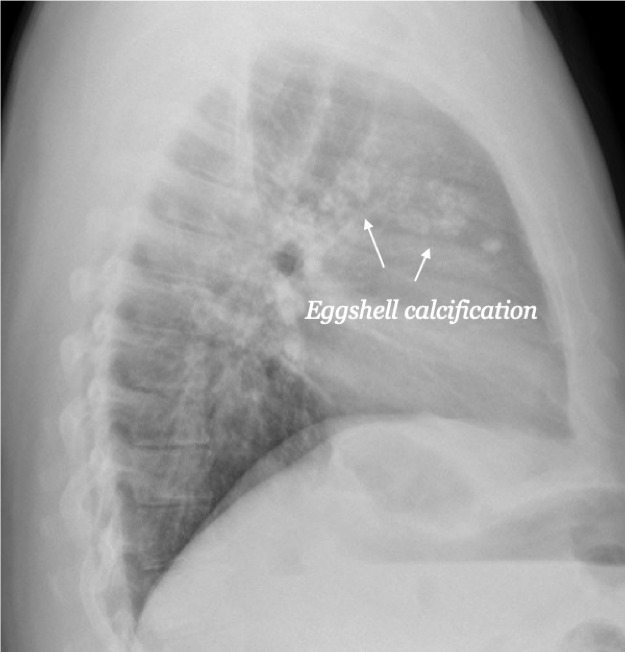

Silicosis - Egg shell calcification
Ferruginous body are found in which anatomical location?
Ferruginous body -Small brown nodules in the septum of the alveolus
Medicine Review MCQs -XI
The drug of choice of cryptococcal meningitis -
[AI -1995]
Induction therapy - Amphotericin B
Tropical spastic paraparesis is caused by -
[AIIMS -2015]
Tropical spastic paraparesis - causes weakness, muscle spasms, and sensory disturbance
Causative agent - Human T-lymphotropic virus [HTLV] resulting in paraparesis
All of the following are TRUE about Ramsay hunt syndrome EXCEPT -
Palatal myoclonus is a rapid spasm of the palatal (roof of the mouth) muscles - due to lesions of the central tegmental tract (which connects the red nucleus to the ipsilateral inferior olivary nucleus). Uniquely, the clicking noise does not subside when the patient sleeps.
All of the following are TRUE about Palatal Myoclonus EXCEPT -
Palatal myoclonus-
Rapid spasm of the palatal (roof of the mouth) muscles, which results in clicking or popping in the ear.
Movements of the palate vary in rate between 40 and 200 beats per minute.
Chronic clonus is often due to lesions of the central tegmental tract (which connects the red nucleus to the ipsilateral inferior olivary nucleus).
Uniquely, the clicking noise does not subside when the patient sleeps.
CSF glucose level is approximately ---------- of Plasma glucose
The glucose level in CSF is proportional to the blood glucose level and corresponds to 60-70% of the concentration in blood.
Normal CSF glucose levels - 45–80 mg/dL
All of the following are TRUE about Cryptococcal neoformans EXCEPT -
AIDS-associated cryptococcosis account for 85% of all patients diagnosed with cryptococcosis
P carinii pneumonia (PCP) the recommended secondary prophylaxis is -
P carinii pneumonia (PCP), the recommended secondary prophylaxis is trimethoprim-sulfamethoxazole
Subdural Empyema is most commonly caused by -
Subdural Empyema most commonly involves -
About 95% of subdural empyemas are located within the cranium
Most subdural empyemas involve the frontal lobe
5% involve the spinal neuraxis.
Commonest cause of Subdural Empyema in cases secondary to cranial trauma -
Commonest cause of Subdural Empyema - cases secondary to cranial trauma or surgical procedures -
- Staphylococcus aureus
Nephrology MCQs- III
Creatinine clearance declines by an average of ---------- after age 40 years as part of the aging process.
Creatinine clearance declines by an average of 0.8 mL/min/yr after age 40 years as part of the aging process.
Creatinine is not a perfect indicator of GFR for the following reasons EXCEPT -
Creatinine is a product of muscle metabolism produced at a relatively constant rate and cleared by renal excretion. Which is good for being a perfect indicator of GFR.
All of the following are exogenous marker for GFR measurement EXCEPT -
Exogenous markers for GFR Measurement -
Inulin, Iohexol, Iothalamate
Endogenous markers for GFR Measurement - GFR is commonly estimated using serum levels of endogenous markers. Creatinine, urea, cystatin C, beta-trace protein, and beta-2 microglobulin.
Reduced BUN levels are seen in -
Reduced BUN levels are seen in liver disease and in the syndrome of inappropriate antidiuretic hormone (SIADH).
BUN : creatinine ratio increases in all of the following EXCEPT -
BUN : creatinine ratio -
low BUN-to-creatinine ratio may be caused by
-diet low in protein,
- severe muscle injury[rhabdomyolysis] ,
- pregnancy, cirrhosis,
- syndrome of inappropriate antidiuretic hormone secretion (SIADH).
All of the following are CORRECT EXCEPT -
Creatinine clearances - overestimate GFR
Urea clearances - underestimate GFR
All of the following are indications of Renal biopsy EXCEPT =
Uncontrollable severe hypertension - Contraindication for Renal Biopsy
AKI is defined as an absolute increase in serum creatinine by --------- within 48 hours
AKI is defined as an absolute increase in serum creatinine by 0.3 mg/dL or more within 48 hours or
a relative increase of at least 1.5 times baseline that is known or presumed to have occurred within 7 days.
RIFLE criteria is used for evaluation of -
RIFLE criteria, proposed by the Acute Dialysis Quality Initiative (ADQI) group, aid in assessment of the severity of a person's acute kidney injury.
AKI can be diagnosed if any one of the following is present EXCEPT:
Introduced by the KDIGO in 2012 - specific criteria exist for the diagnosis of AKI.
AKI can be diagnosed if any one of the following is present:
Increase in SCr by ≥0.3 mg/dl (≥26.5 μmol/l) within 48 hours; or
Increase in SCr to ≥1.5 times baseline, which has occurred within the prior 7 days; or
Urine volume < 0.5 ml/kg/h for 6 hours.
Nephrology MCQs-II
Proteinuria in adults is defined as excessive protein excretion in the urine, generally greater than --------------
Proteinuria is defined as excessive protein excretion in the urine, generally greater than 150 mg/24 hours in adults
Which of the following cast is not indicative of kidney disease ?
Hyaline casts - Not indicative of kidney disease
Hyaline casts seen in cases -
- Concentrated urine,
- febrile disease,
- diuretic therapy,
- after strenuous exercise
Red cell casts - Glomerulonephritis
White cell casts - Indicative of infection or inflammation, Pyelonephritis, interstitial nephritis,
Renal tubular cell casts -Acute tubular necrosis, interstitial nephritis
Granular (muddy brown) casts- Nonspecific; can indicate acute tubular necrosis
Bence Jones proteins are missed with dipstick analysis because -
Evaluation of proteinuria by urine dipstick does not actually measure protein but instead detects the negative electrochemical charge that characterizes albumin.
Bence Jones proteins - positively charged so Bence Jones proteins are missed with dipstick analysis.
Urine dipstick for proteins DIRECTLY detects -
Evaluation of proteinuria by urine dipstick does not actually measure protein but instead detects the negative electrochemical charge that characterizes albumin.
Urine protein to creatinine ratio (P/C ratio) is a fast and simple method of detecting -
Urine protein to creatinine ratio (P/C ratio) is an alternative, fast and simple method of detecting and estimating the quantitative assessment of proteinuria.
Bence Jones proteins can be detected by the addition of --------------- to the urine specimen
Bence Jones proteins can be detected by the addition of sulfosalicylic acid to the urine specimen
Creatinine clearance is approximately -------- mL/min in healthy young men
Creatinine clearance is approximately 100 mL/min in healthy young women and 120 mL/min in healthy young men
Cockcroft-Gault formula is used to measure -
Cockcroft-Gault formula: Estimated creatinine clearance rate (eCCR)
Creatinine clearance can be estimated using serum creatinine levels.
Cockcroft-Gault formula uses all of the following EXCEPT -
The resulting CrCl is multiplied by 0.85 if the patient is female to correct for the lower CrCl in females.
Which is the main predictor for Creatinine clearance in Cockcroft-Gault formula?
The Cockcroft-Gault formula is dependent on age as its main predictor for Creatinine clearance.
Nephrology MCQs-I
Urinalysis should be done within ------------------- after collection to avoid destruction of formed elements.
Urinalysis should be done within 1 hour after collection to avoid destruction of formed elements.
Precipitation of Tamm-Horsfall mucoprotein in the renal tubule and formation of urinary casts are likely to form when -
Tamm-Horsfall protein (THP) is exclusively produced by renal tubular cells of the -
Distal loop of Henle
All of the following are correct regarding Bence Jones protein EXCEPT -
Detection of Bence Jones protein may be suggestive of multiple myeloma or Waldenström's macroglobulinemia. More common are kappa chains (most of the time) than lambda
Tamm–Horsfall protein also known as -
myeloma protein - -M protein, M component, M spike, spike protein, or paraprotein.
Uromodulin (UMOD), also known as Tamm–Horsfall protein (THP), is a Zona pellucida-like domain-containing glycoprotein
Urinary Cast formation is pronounced in environments - 1. Low flow, 2. Concentrated salts, 3. Low pH
Cast formation is pronounced in environments favoring protein denaturation and precipitation (low flow, concentrated salts, low pH)
All of the following are TRUE about Hyaline casts EXCEPT -
Low urine flow, concentrated urine, or an acidic environment can contribute to the formation of hyaline casts
Findings of muddy brown casts in urine sediment are highly suggestive of -
Findings of granular, muddy brown casts in urine sediment are highly suggestive of tubular necrosis
Red blood cell casts seen in all EXCEPT-
Red blood cells within the cast is always pathological and is strongly indicative of granulomatosis with polyangiitis, systemic lupus erythematosus, post-streptococcal glomerulonephritis, or Goodpasture's syndrome.
White blood cell casts
Indicative of inflammation or infection, the presence of white blood cells within or upon casts strongly suggests pyelonephritis,
In Acute tubular necrosis the diagnosis is made by a FENa (fractional excretion of sodium)-
Acute tubular necrosis is classified as a "renal" (i.e. not pre-renal or post-renal) cause of acute kidney injury.
Diagnosis is made by a FENa (fractional excretion of sodium) > 3% and presence of muddy casts (a type of granular cast) in urinalysis.
Medicine Review MCQs-X
Which of the following is a Melanocyte derived Giant cell -
Starburst giant cells are multi-nucleated melanocytes with a stellate appearance due to its prominent dendritic processes. These are useful indicator for the diagnosis of lentigo maligna from photo-damaged skin
Lentigo maligna is a subtype of melanoma in situ that is characterized by an atypical proliferation of melanocytes within the basal epidermis; lentigo maligna that invades the dermis is termed lentigo maligna melanoma
Warthin–Finkeldey cell is a type of giant cell found in -
Warthin–Finkeldey giant cell found in
- Hyperplastic lymph nodes early in the course of measles
- HIV-infected individuals,
- Kimura disease,
- Rarely in neoplastic (e.g. lymphoma) and non-neoplastic lymph node disorders
Tzanck giant cells seen in all of the following EXCEPT -
Tzanck giant cells
Multi-nucleated giant cell with molding of the nuclei as they are crowded together.
These are epidermal cells that are much larger than the normal epidermal cells.
What is the order of Giant cells -
Langhans’ Giant Cells , Foreign body giant cells, Touton Giant Cell


Which organism associated with rat-bite fever?
Spirillum minus is an organism associated with rat-bite fever .
It stains gram-negative and has a coiled rod shape.
“Henderson-Patterson’s bodies” seen in -
Henderson-Paterson bodies, can measure 35µm in diameter. Ultrastructural studies have shown that these bodies are membrane-bound sacs that contain numerous molluscum contagiosum virions
In which of the following Cytological Examination shows -Cigar-shaped spindle cells?
Kaposi’s sarcoma
Kaposi’s sarcoma is caused by a combination of immune suppression (such as due to HIV/AIDS) and infection by Human herpesvirus 8 (HHV8 - also called KS-associated herpesvirus (KSHV)
Koilocyte is a type of squamous epithelial cell seen after viral infection with -
koilocyte is a squamous epithelial cell that has undergone a number of structural changes
koilocyte is found due to infection of the cell by human papillomavirus (HPV).
Leishman-Donovan bodies seen in cytological examination of -
L. donovani is the causative agent of visceral leishmaniasis, known as kala-azar ("black fever", particularly in India)
What is the causative organism of cat-scratch disease?
Spirillum minus - an organism associated with rat-bite fever
Bartonella henselae - causative organism in cat-scratch disease

















